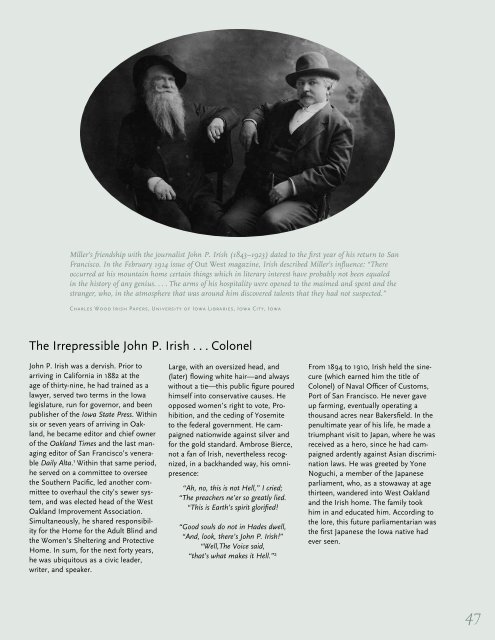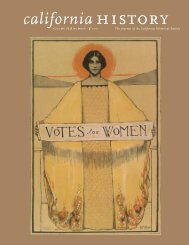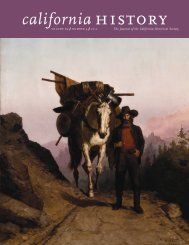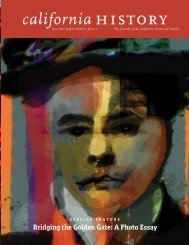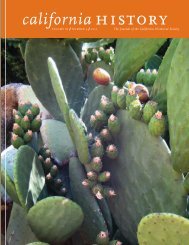Volume 90, Number 1 - California Historical Society
Volume 90, Number 1 - California Historical Society
Volume 90, Number 1 - California Historical Society
Create successful ePaper yourself
Turn your PDF publications into a flip-book with our unique Google optimized e-Paper software.
Miller’s friendship with the journalist John P. Irish (1843–1923) dated to the first year of his return to San<br />
Francisco. In the February 1914 issue of Out West magazine, Irish described Miller’s influence: “There<br />
occurred at his mountain home certain things which in literary interest have probably not been equaled<br />
in the history of any genius. . . . The arms of his hospitality were opened to the maimed and spent and the<br />
stranger, who, in the atmosphere that was around him discovered talents that they had not suspected.”<br />
Charles Wood Irish Papers, University of Iowa Libraries, Iowa City, Iowa<br />
The Irrepressible John P . Irish . . . Colonel<br />
John P. Irish was a dervish. Prior to<br />
arriving in <strong>California</strong> in 1882 at the<br />
age of thirty-nine, he had trained as a<br />
lawyer, served two terms in the Iowa<br />
legislature, run for governor, and been<br />
publisher of the Iowa State Press. Within<br />
six or seven years of arriving in Oakland,<br />
he became editor and chief owner<br />
of the Oakland Times and the last managing<br />
editor of San Francisco’s venerable<br />
Daily Alta. 1 Within that same period,<br />
he served on a committee to oversee<br />
the Southern Pacific, led another committee<br />
to overhaul the city’s sewer system,<br />
and was elected head of the West<br />
Oakland Improvement Association.<br />
Simultaneously, he shared responsibility<br />
for the Home for the Adult Blind and<br />
the Women’s Sheltering and Protective<br />
Home. In sum, for the next forty years,<br />
he was ubiquitous as a civic leader,<br />
writer, and speaker.<br />
Large, with an oversized head, and<br />
(later) flowing white hair—and always<br />
without a tie—this public figure poured<br />
himself into conservative causes. He<br />
opposed women’s right to vote, Prohibition,<br />
and the ceding of Yosemite<br />
to the federal government. He campaigned<br />
nationwide against silver and<br />
for the gold standard. Ambrose Bierce,<br />
not a fan of Irish, nevertheless recognized,<br />
in a backhanded way, his omnipresence:<br />
“Ah, no, this is not Hell,” I cried;<br />
“The preachers ne’er so greatly lied.<br />
“This is Earth’s spirit glorified!<br />
“Good souls do not in Hades dwell,<br />
“And, look, there’s John P. Irish!”<br />
“Well,The Voice said,<br />
“that’s what makes it Hell.” 2<br />
From 1894 to 1910, Irish held the sinecure<br />
(which earned him the title of<br />
Colonel) of Naval Officer of Customs,<br />
Port of San Francisco. He never gave<br />
up farming, eventually operating a<br />
thousand acres near Bakersfield. In the<br />
penultimate year of his life, he made a<br />
triumphant visit to Japan, where he was<br />
received as a hero, since he had campaigned<br />
ardently against Asian discrimination<br />
laws. He was greeted by Yone<br />
Noguchi, a member of the Japanese<br />
parliament, who, as a stowaway at age<br />
thirteen, wandered into West Oakland<br />
and the Irish home. The family took<br />
him in and educated him. According to<br />
the lore, this future parliamentarian was<br />
the first Japanese the Iowa native had<br />
ever seen.<br />
47


